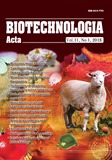ISSN 2410-7751 (Print)
ISSN 2410-776X (Online)

"Biotechnologia Acta" V. 11, No 1, 2018
Р. 76-81, Bibliography 25, English
Universal Decimal Classification: 576.3+612.014.2/3
https://doi.org/10.15407/biotech11.01.076
ISOLATION OF MULTIPOTENT MESENCHIMAL STROMAL CELLS FROM MINIMAL HUMAN ENDOMETRIUM BIOPSY
1State Institute of Genetic and Regenerative Medicine of National Academy of Medical Sciences of Ukraine, Kiev
2Biotechnology Laboratory “ilaya Regeneration”, Medical Company ilaya, Kiev
3Institute of Molecular Biology and Genetics of National Academy of Sciences of Ukraine, Kyiv
The aim of the research was establishing a cell culture from a minimal human endometrial biopsy and assessment its conformity with the criteria for multipotent mesenchymal stromal cells. It was shown that cells in the culture possess adhesion to plastic, have characteristic fibroblast-like morphology, express CD73+CD90+CD105+, and are negative for hematopoietic markers (CD34-CD45-HLA-DR-), have the ability to directed adipogenic, osteogenic and chondrogenic differentiation. Due to these properties, the cell population isolated from the minimal endometrial biopsy can be attributed to multipotent mesenchymal stromal cells.
Key words: human endometrium, multipotent mesenchymal stromal cells.
© Palladin Institute of Biochemistry of National Academy of Sciences of Ukraine, 2018
References
1. Kasius A., Smit J. G., Torrance H. L., Eijkemans M. J., Mol B. W., Opmeer B. C., Broekmans F. J. Endometrial thickness and pregnancy rates after IVF: a systematic review and meta-analysis. Hum. Reprod. Update.2014, 20(4), 530–541. https://doi.org/10.1093/humupd/dmu011
2. Margalioth E.J., Ben-Chetrit A., Gal M. Eldar-Geva T. Investigation and treatment of repeated implantation failure following IVF-ET. Hum. Reprod. 2006, 21(12), 3036–3043. https://doi.org/10.1093/humrep/del305
3. Korneeva I.E. Modern concept of diagnosis and treatment of infertility in marriage. (Doctoral dissertation). Available from disserCat database 2006. (UMI No. 395491). (In Russian)
4. Haydukov S.N., Boiarskiy Y.K., Palchenko N.A. Modern view on the problem of receptivity and
thin endometrium in ART programs. Problemy reproduktsiyi.2013, V. 4, P. 51–60. (In Russian).
5. Murphy M.B., Moncivais K., Caplan A.I. Mesenchymal stem cells: environmentally responsive therapeutics for regenerative medicine. Exp. Mol. Med. 2013, V. 45, P. 54. https://doi.org/10.1038/emm.2013.94
6. Doorn J., Moll G., Le Blanc K. Therapeutic applications of mesenchymal stromal cells: paracrine effects and potential improvements. Tissue Eng. 2012, 18(2), 101–115. https://doi.org/10.1089/ten.teb.2011.0488
7. Caplan A.I. Why are MSCs therapeutic? New data: new insight. 2009, V. 217, P. 318–324.
https://doi.org/10.1002/path.2469
8. Gnecchi M1, Melo LG.Bone marrow-derived mesenchymal stem cells: isolation, expansion,
characterization, viral transduction, and production of conditioned medium. Meth. Mol. Biol. 2009, V. 482, P. 281–294. https://doi.org/10.1007/978-1-59745-060-7_18
9. Dhanasekaran M., Indumathi S., Poojitha R., Kanmani A., Rajkumar J.S., Sudarsanam D.
Plasticity and banking potential of cultured adipose tissue derived mesenchymal stem cells. Cell Tissue Bank.2013, 14(2), 303–315. https://doi.org/10.1007/s10561-012-9311-7
10. Kara?z E., Do?an B. N., Aksoy A., Gacar G., Aky?z S., Ayhan S., Gen?Z. S., Y?r?ker S., Duruksu G., Demircan P. C., Sariboyaci A. E.Isolation and in vitro characterisation of dental pulp stem cells from natal teeth. Histochem. Cell Biol. 2010, 133(1), 95–112.
https://doi.org/10.1007/s00418-009-0646-5
11.Manini I., Gulino L., Gava B., Pierantozzi E., Curina C., Rossi D., Brafa A., D’Aniello C., Sorrentino V.Multipotent progenitors in freshly isolated and cultured human mesenchymal stem
cells: a comparison between adipose and dermal tissue. Cell Tissue Res. 2011, 344(1), 85–95.
https://doi.org/10.1038/emboj.2012.301
12. Romanov Y. A., Svintsitskaya V. A., Smirnov V. N. Searching for alternative sources of postnatal human mesenchymal stem cells: candidate MSC-like cells from umbilical cord. Stem Cells. 2003, 21(1), 105–10. https://doi.org/10.1634/stemcells.21-1-105
13. Fukuchi Y., Nakajima H., Sugiyama D., Hirose I., Kitamura T., Tsuji K. Human placenta-derived cells have mesenchymal stem/progenitor cell potential. Stem Cells.2004, 22(5), 649–58. https://doi.org/10.1634/stemcells.22-5-649
14. Sasson I. E., Taylor H. S. Stem cells and the pathogenesis of endometriosis. Ann. N. Y.
Acad. Sci. 2008, V. 1127, P. 106–15. https://doi.org/10.1196/annals.1434.014
15. Padykula H. A. Regeneration in the primate uterus: the role of stem cells. Ann. N. Y, Acad.
Sci. 1991, V. 622, P. 47–56.
16. Gargett C. E.Stem cells in gynaecology. Aust. N. Z. J. Obstet. Gynecol.,2004, 44(5), 380-386.
https://doi.org/10.1111/j.1749-6632.2011.05969.x
17. Gargett C. E. Identification and characte-ri zation of human endometrial stem/progenitor cells.
Austr. New Zealand J. Experimental articles 81Obstetrics Gynecol. 2006, V. 46, P. 250–253.
https://doi.org/10.1530/REP-07-0428
18. Xiaolong Meng. Endometrial regenerative cells: A novel stem cell population. J. Transl. Med.
2007, V. 5, P. 57. https://doi.org/10.1186/1479-5876-5-57
19. Dominici M1, Le Blanc K., Mueller I., Slaper-Cortenbach I., Marini F., Krause D., Deans R., Keating A., Prockop Dj, Horwitz E. Minimal criteria for defining multipotent mesenchymal stromal cells. The International Society for Cellular Therapy position statement. Cytotherapy.
2006, 8(4), 315–317. https://doi.org/10.1080/14653240600855905
20. Prockop D., Phinney D., Blundell B. Mesenchymal stem cells: methods and protocols. Meth. Mol. Biol 2008, V. 449, P. 192.
21. Gimble J. M., Guilak F.Adipose-derived adult stem cells: isolation, characterization, and differentiation potential. Cytotherapy. 2003, 5(5), 362–369. https://doi.org/10.1080/14653240310003026
22. Baer P., Geiger Н.Adipose-Derived Mesen chymal Stromal/Stem Cells: Tissue Localization,
Characterization, and Heterogeneity.Stem Cells Int. 2012, V. 2012, P. 1–11.
https://doi.org/10.1155/2012/812693
23. Timper K., Seboek D., Eberhardt M. “Human adipose tissue-derived mesenchymal stem cells differentiate into insulin, somatostatin, and glucagon expressing cells. Biochem. Biophys. Res. Commun. 2006, 341(4), 1135–1140. https://doi.org/10.1016/j.bbrc.2006.01.072
24. Pittenger M., Mackay A., Beck S., Jaiswal R., Douglas R. Multilineage Potential of Adult
Human Mesenchymal Stem Cells. Science. 1999, 284(5411), 143–147. https://doi.org/10.1126/science.284.5411.143
25. Kilroy G. E., Foster S. J., Wu X. et al.“Cytokine profile of human adipose-derived stem cells:
expression of angiogenic, hematopoietic, and pro-inflammatory factors,” J. Cell. Physiol.
2007, 212(3), 702–709.

